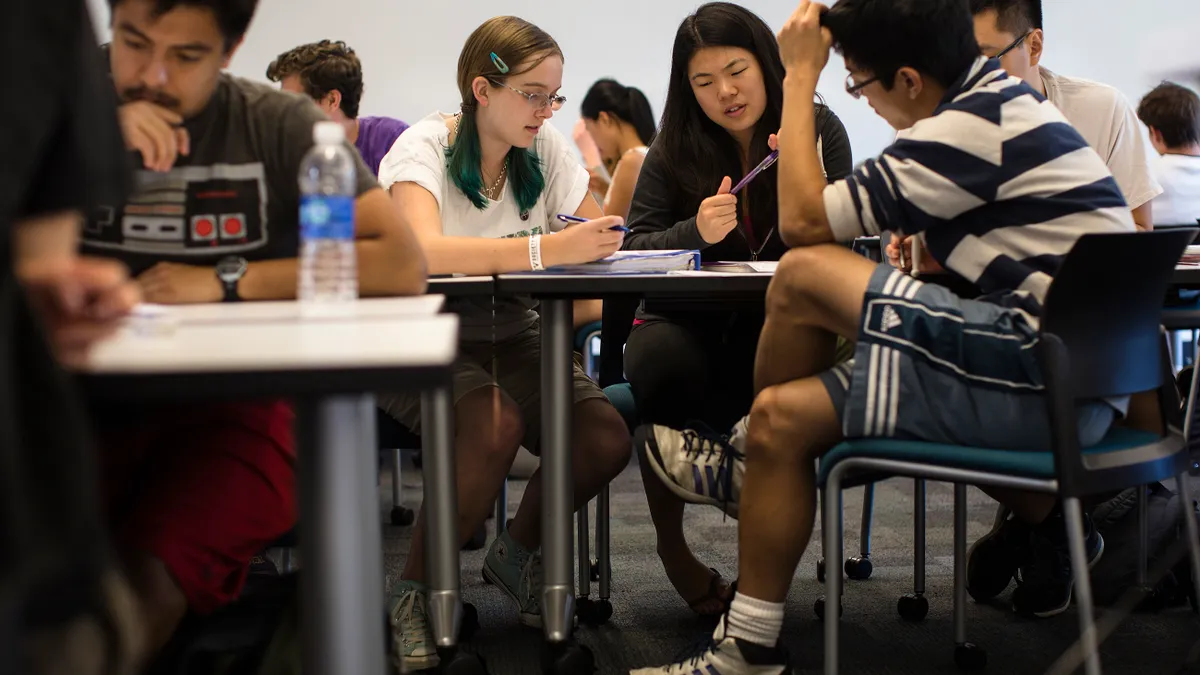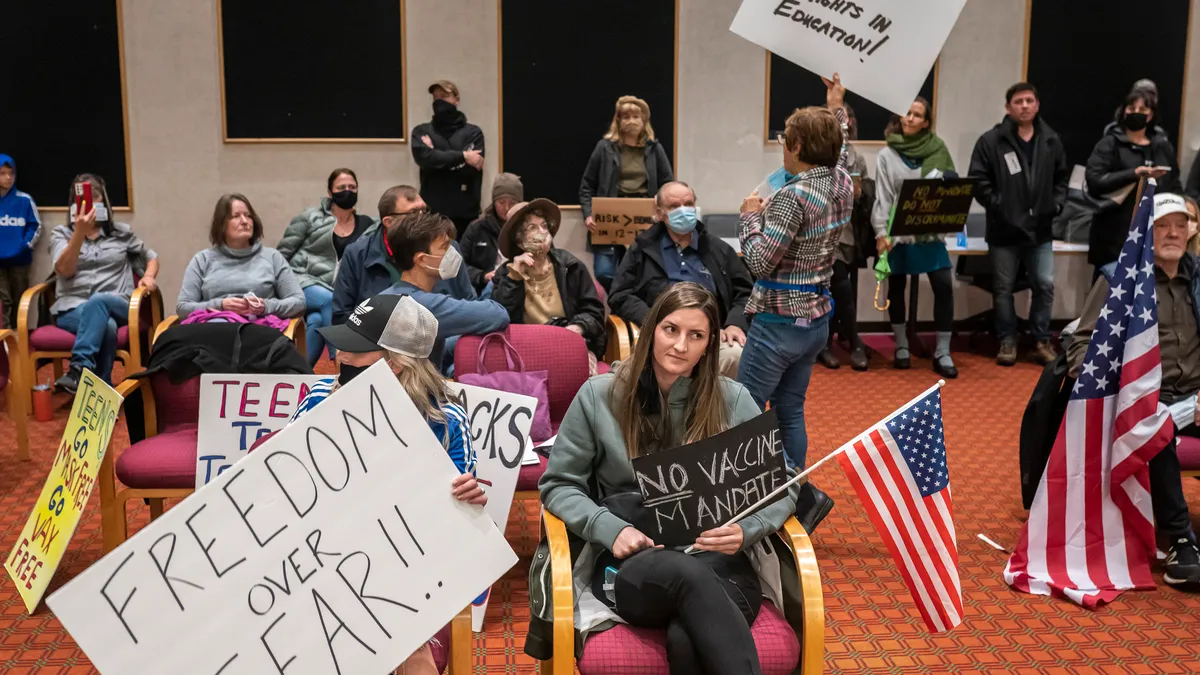When officials in the North Dakota Department of Public Instruction were deciding on which nonacademic indicator to include in their accountability plan to comply with the Every Student Succeeds Act (ESSA), they decided to take a different direction than most states.
While most states are tracking chronic absenteeism rates to measure student success, North Dakota decided instead to monitor student engagement using a survey developed by AdvancED.
“Chronic absenteeism is a symptom of something else going on,” state Superintendent Kirsten Baesler said earlier this year when she spoke at the Education Writers Association annual conference in Los Angeles. “The committee felt that [chronic absenteeism] wasn’t getting to the heart of what we need to address.”
While over 86% of the state’s students graduate from high school, Baesler noted that too many students are merely “compliant” and therefore not successful when they reach college. “We give them a diploma,” she said, “but they are not really ready to move on.”
Putting 'forward the required effort'
At one time, student engagement — one element of school climate — was largely thought to be whether students were paying attention in class, author and researcher Robert Marzano said in an interview.
But now educators recognize that it encompasses a variety of behaviors that demonstrate students’ interest in what they are doing in school and whether they feel it has any relevance to their lives. A 2015 report from the Brookings Institution described student engagement as “the intensity with which students apply themselves to learning in school.”
According to an AdvancED definition, students are engaged when they show commitment to learning in the classroom as well as out of school. “They willingly put forward the required effort to find a level of personal success academically, socially and emotionally,” they write.
ESSA may also be an opportunity for officials to learn how federal or state education policy can increase student engagement, Anna J. Markowitz, a researcher from the University of Virginia, writes in a recent study appearing in the American Educational Research Journal.
Analyzing data from the National Longitudinal Survey of Youth, Markowitz finds that No Child Left Behind's (NCLB) emphasis on standardized testing and holding schools accountable for hitting student proficiency targets may have at first increased students' engagement in school in contrast to what many predicted. But over time, she found that engagement declined and that there was a negative relationship between NCLB and student engagement.
"For practitioners and policymakers to make the most of the flexibility ushered in with ESSA, it is critical that research identify the key policy levers for building student engagement and that changes to NCLB-era accountability systems do not discard these valuable provisions," she writes.
An analysis by FutureEd, a think tank based at Georgetown University, shows that a handful of other states — Idaho, Illinois, Iowa, Maryland, Nebraska and South Carolina — are also using student surveys as some part of their ESSA plans. Montana’s plan mentions the use of a survey but doesn’t specify whether it’s one taken by students.
Policymakers and education leaders began to put more stock in student feedback systems after the Tripod survey was used as part of the Bill and Melinda Gates Foundation’s Measures of Effective Teaching study and showed that student survey results are a reliable predictor of achievement gains — even more than a strong classroom observation system.
“Even a high-quality observation system entails at most a handful of classroom visits, while student surveys aggregate the impressions of many individuals who’ve spent many hours with a teacher,” wrote the authors of a Gates Foundation brief on student perception surveys.
Alka Pateriya, the vice president of Tripod Education Partners, said that it’s difficult for adults to determine whether students are engaged if a class seems rowdy or disorganized. “If classroom management is a disaster, that clouds the observer’s ability to see anything else well,” she said in an interview, but added that “kids are able to parse that out.”
The MET results, combined with the focus on social-emotional learning and a growing emphasis on including students’ voices in matters that affect them at school, have contributed to surveys now being used as part of states’ accountability systems, Pateriya said.
“We believe kids know and should be listened to about their feedback,” she said. “We’ve always been standing on that mountain and shouting that gospel.”
Going beyond surveys
The way survey questions are worded, however, can cause controversy. For example, the Idaho State Board of Education replaced a student survey developed by Panorama because some school administrators thought the questions were biased against educators. In February, the board opted to go with the AdvancED survey instead.
Surveys alone, however, won’t make students feel more positive about school or give school leaders direction on how to improve engagement, experts say.
If a survey “doesn’t point to things you can do when kids aren’t engaged, it doesn’t help you a lot,” Marzano said. He and others recommend additional focus groups to dig deeper into the survey results; to better understand how students’ responses differ by race, ethnicity or gender; and to allow students to suggest ways to improve their school.
In a chapter that is part of a forthcoming book published by Harvard Education Press, Robert Mayo and David Osher of the American Institutes for Research describe the Cleveland (Ohio) Metropolitan School District’s high school student advisory committees, which are intended to represent a broad cross-section of students. The students meet regularly to discuss tough topics, such as chronic absenteeism, relationships between youth and law enforcement, and equity and inclusion. They often make recommendations that they present to school leadership teams.
“While educators often only think of academic engagement, youth engagement also has other meanings,” they write. “From a positive youth development perspective, youth engagement refers to sustained connections that young people have with their school, community and with other youth and families as well as to youth voice, youth involvement, youth participation and youth governance.”
North Dakota leaders also aren’t the only ones suggesting that chronic absenteeism may not be the best measure of school climate or student engagement. In a blog post last fall, researchers from Child Trends suggested that the more than 30 states choosing chronic absenteeism as part of their fifth measure may be missing an opportunity to focus on students’ healthy development.
“While chronic absenteeism will certainly bolster educators’ understanding of the underlying issues that influence academic achievement,” they write, “this metric alone cannot help a school detect the specific challenges in need of attention.”
Osher is also working on a book chapter with Hedy Chang, executive director of Attendance Works, that focuses on how addressing chronic absenteeism may not resolve deeper issues standing in the way of learning.
"You get me back in school and I'm not engaged. That’s not enough," Osher said. "The real question is what’s happening when I'm in school."







 Dive Awards
Dive Awards















